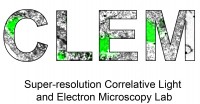Liquid–liquid phase separation mediates the formation of herpesvirus assembly compartments
Virus assembly, which takes place during the late stage of viral replication, is essential for virus propagation. However, the underlying mechanisms remain poorly understood, especially for viruses with complicated structures. Here, we use correlative light and electron microscopy to examine the formation of cytoplasmic virion assembly compartments (cVACs) during infection by a γ-herpesvirus. These cVACs are membraneless organelles with liquid-like properties. Formation of cVACs during virus infection is mediated by ORF52, an abundant tegument protein. ORF52 undergoes liquid–liquid phase separation (LLPS), which is promoted by both DNA and RNA. Disrupting ORF52 phase separation blocks cVACs formation and virion production. These results demonstrate that phase separation of ORF52 is critical for cVACs formation. Our work defines herpesvirus cVACs as membraneless compartments that are generated through a process of LLPS mediated by a tegument protein and adds to the cellular processes that are facilitated by phase separation.
期刊:
Journal of Cell Biology
2022
作者:
Hongyu Deng,Pingyong Xu,Pu Gao,Fei Sun,Long Sun,Guangjun Xu,Xing Jia,Ziwei Zhang,Zhifei Fu,Sheng Zhou
DOI:10.1083/jcb.202201088
Regulation of wakefulness by GABAergic dorsal raphe nucleus-ventral tegmental area pathway
Abstract
The dorsal raphe nucleus (DRN) has previously been proved to be involved in the regulation of the sleep–wake behavior. DRN contains several neuron types, such as 5-HTergic and GABAergic neurons. GABAergic neurons, which are the second largest cell subtype in the DRN, participate in a variety of neurophysiological functions. However, their role in sleep–wake regulation and the underlying neural circuitry remains unclear. Herein, we used fiber photometry and synchronous electroencephalogram (EEG)/electromyography (EMG) recording to demonstrate that DRN GABAergic neurons exhibit high activities during wakefulness and low activities during NREM sleep. Short-term optogenetic activation of DRN GABAergic neurons reduced the latency of NREM-to-wake transition and increased the probability of wakefulness, while long-term optogenetic activation of these neurons significantly increased the amount of wakefulness. Chemogenetic activation of DRN GABAergic neurons increased wakefulness for almost 2 h and maintained long-lasting arousal. In addition, inhibition of DRN GABAergic neurons with chemogenetics caused a reduction in the amount of wakefulness. Finally, similar to the effects of activating the soma of DRN GABAergic neurons, optogenetic stimulation of their terminals in the ventral tegmental area (VTA) induced instant arousal and promoted wakefulness. Taken together, our results illustrated that DRN GABAergic neurons are vital to the induction and maintenance of wakefulness, which promote wakefulness through the GABAergic DRN-VTA pathway.
期刊:
Sleep
2022
作者:
Li Chen,Wen-Xiang Wang,Zhifei Fu,Sheng-Nan Huang,Yu-Hang Zeng,Wen-Hao Xiao,Cong-Wen Zhuang,Wei-Tao Tang,Zhi-Hui Lin,Yu-Tong Cai,Zhong-Hua Zhu,Zhang-Shu Li,Ren-Fu Liu,Yu-Duan Hu,Wen-Feng Wang,Jing Yao,Fu-Dan Wang,Ping Cai
DOI:10.1093/sleep/zsac235
The pleiotropic functions of intracellular hydrophobins in aerial hyphae and fungal spores
Higher fungi can rapidly produce large numbers of spores suitable for aerial dispersal. The efficiency of the dispersal and spore resilience to abiotic stresses correlate with their hydrophobicity provided by the unique amphiphilic and superior surface-active proteins–hydrophobins (HFBs)–that self-assemble at hydrophobic/hydrophilic interfaces and thus modulate surface properties. Using the HFB-enriched mold Trichoderma (Hypocreales, Ascomycota) and the HFB-free yeast Pichia pastoris (Saccharomycetales, Ascomycota), we revealed that the rapid release of HFBs by aerial hyphae shortly prior to conidiation is associated with their intracellular accumulation in vacuoles and/or lipid-enriched organelles. The occasional internalization of the latter organelles in vacuoles can provide the hydrophobic/hydrophilic interface for the assembly of HFB layers and thus result in the formation of HFB-enriched vesicles and vacuolar multicisternal structures (VMSs) putatively lined up by HFBs. These HFB-enriched vesicles and VMSs can become fused in large tonoplast-like organelles or move to the periplasm for secretion. The tonoplast-like structures can contribute to the maintenance of turgor pressure in aerial hyphae supporting the erection of sporogenic structures (e.g., conidiophores) and provide intracellular force to squeeze out HFB-enriched vesicles and VMSs from the periplasm through the cell wall. We also show that the secretion of HFBs occurs prior to the conidiation and reveal that the even spore coating of HFBs deposited in the extracellular matrix requires microscopic water droplets that can be either guttated by the hyphae or obtained from the environment. Furthermore, we demonstrate that at least one HFB, HFB4 in T. guizhouense, is produced and secreted by wetted spores. We show that this protein possibly controls spore dormancy and contributes to the water sensing mechanism required for the detection of germination conditions. Thus, intracellular HFBs have a range of pleiotropic functions in aerial hyphae and spores and are essential for fungal development and fitness.
期刊:
PLOS Genetics
2021
作者:
Irina S. Druzhinina,Günseli Bayram Akcapinar,Qirong Shen,Komal Chenthamara,Pingyong Xu,Zhifei Fu,Siqi Jiang,Mingyue Ding,Peijie Chen,Renwei Gao,Zheng Zhao,Feng Cai
DOI:10.1371/journal.pgen.1009924
A protocol for Epon-embedding-based correlative super-resolution light and electron microscopy
Abstract
This protocol describes a detailed step-by-step sample preparation procedure for Epon based post-embedding correlative super-resolution light and electron microscopy (SR-CLEM). The newly developed fluorescent protein, mEosEM, is the core in this protocol. The advantage of this method is to simultaneously obtain high-quality LM and EM images from the same ultrathin section of Epon-embedded sample after conventional chemical fixation.
作者:
Wenting He,Rui Zhang,Fudong Xue,Dingming Peng,Zhifei Fu,Mingshu Zhang,Tao Xu,Pingyong Xu
DOI:10.21203/rs.2.13841/v1
mEosEM withstands osmium staining and Epon embedding for super-resolution CLEM
期刊:
Nature Methods
2019
作者:
Pingyong Xu,Tao Xu,Wenting He,Rui Zhang,Fudong Xue,Mingshu Zhang,Dingming Peng,Zhifei Fu
DOI:10.1038/s41592-019-0613-6
Extending the spatiotemporal resolution of super-resolution microscopies using photomodulatable fluorescent proteins
In the past two decades, various super-resolution (SR) microscopy techniques have been developed to break the diffraction limit using subdiffraction excitation to spatially modulate the fluorescence emission. Photomodulatable fluorescent proteins (FPs) can be activated by light of specific wavelengths to produce either stochastic or patterned subdiffraction excitation, resulting in improved optical resolution. In this review, we focus on the recently developed photomodulatable FPs or commonly used SR microscopies and discuss the concepts and strategies for optimizing and selecting the biochemical and photophysical properties of PMFPs to improve the spatiotemporal resolution of SR techniques, especially time-lapse live-cell SR techniques.
期刊:
Journal of Innovative Optical Health Sciences
2016
作者:
Pingyong Xu,Zhifei Fu,Mingshu Zhang
DOI:10.1142/s1793545816300093







